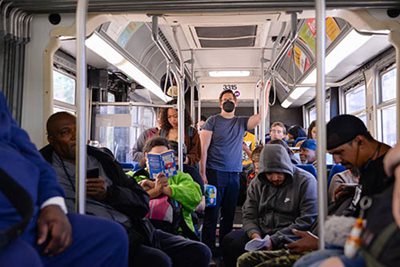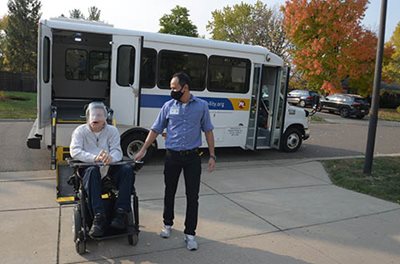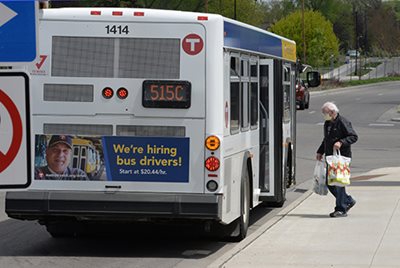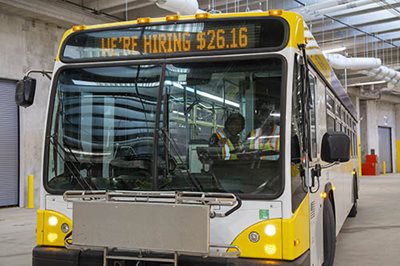 Transit ridership in the Twin Cities metro region rebounded significantly in 2022, offering hope for additional growth in 2023.
Transit ridership in the Twin Cities metro region rebounded significantly in 2022, offering hope for additional growth in 2023.
The Metropolitan Council reported an overall 17% increase in ridership on the services it provides, including Metro Transit, contracted routes, Metro Mobility, and Transit Link.
In all, more than 42 million rides were provided by the Met Council last year, up from about 36 million rides in 2021. The steady growth is a sign that transit continues to serve a vital role as a link to jobs, education, and other opportunities.
“We have some good news with where we sit with ridership,” said John Harper, manager of contracted transit services for the Met Council. “Every number is a positive number, an increase in ridership.”
The Met Council — which operates Metro Transit, by far the state’s largest transit provider — also works with other transit providers, including Minnesota Valley Transit Authority (MVTA), SouthWest Transit, Maple Grove Transit, Plymouth Metrolink, and the University of Minnesota. Collectively, more than 45 million rides were provided by the Met Council and suburban providers in 2022, a 21% increase from 2021.
Met Council staff presented the full ridership report (PDF) at the February 13 Transportation Committee meeting.
More passengers for all transit modes
Metro Transit fixed-route buses remained the region’s most popular mode of public transportation with more than 27 million rides, an 18% increase from 2021.
Bus rapid transit (BRT) routes, which have limited stops and off-board fare collection, now account for about 10% of regional rides. The METRO Orange Line spanning from Minneapolis to Burnsville opened in late 2021, and the METRO D Line linking Brooklyn Center and Mall of America opened in December 2022, substantially replacing the state’s busiest bus route, Route 5.
“Every time we open an arterial BRT line, we see immediate growth, mostly on the weekend,” said Eric Lind, research and analytics manager. “BRT upgrades the experience with upgraded vehicles, speed, and reliability.”
 In addition, express service — limited-stop buses that transport commuters into the city from free suburban park-and-ride lots — increased by 40% in 2022.
In addition, express service — limited-stop buses that transport commuters into the city from free suburban park-and-ride lots — increased by 40% in 2022.
“The pandemic has been tough,” said Harper. “It delivered quite the hit on all ridership, and express service was hit hardest. We’re recovering now.”
Among other modes of transport, light rail ridership increased by 16% in 2022 with more than 12 million rides. Metro Mobility ridership improved by 7% and is now operating at more than 80% of pre-pandemic levels, representing the strongest recovery in the transit system.
In addition, Transit Link saw ridership gains of 9% and vanpool commuter services jumped by 49%.
Adjusting to new travel trends and patterns
The pandemic changed the way people work, shop, socialize, and travel. Fortunately, data experts now have nearly two full years of research from tens of millions of trips to study trends and patterns that can help the Met Council provide better service to its customers.
 "We are advancing a vision that’s greater than simply returning to where we were before the pandemic,” said Lesley Kandaras, interim general manager for Metro Transit. “This is about moving forward to understand and meet the evolving needs of our customers and the communities we serve."
"We are advancing a vision that’s greater than simply returning to where we were before the pandemic,” said Lesley Kandaras, interim general manager for Metro Transit. “This is about moving forward to understand and meet the evolving needs of our customers and the communities we serve."
Many people work for companies with flexible hybrid or work-from-home policies. In fact, a recent Gallup poll indicated that only about 20% of remote-capable respondents work entirely onsite. Ridership numbers seem to reflect this trend.
Ridership is lower on Mondays and Fridays, two of the more popular days for employees to work remotely. In addition, morning and afternoon peaks are no longer equal. In fact, 3 p.m. is now the busiest time of day for transit for the first time.
“Ridership trends are less predictable than in the past,” said Lind. “People are moving in all directions at all times of day.”

Adding operators to increase service
Metro Transit continues its quest to attract and hire more bus and train operators, and will add back service as staffing levels and other resources allow. At the beginning of 2023, Metro Transit was about 200 operators short of its budgeted total but seeing encouraging signs of growing interest.
In 2022, the agency increased starting wages to $26.16 an hour, began offering paid training to applicants who did not yet have a Commercial Drivers License Permit, and began inviting external train operator applications for the first time. Find information about becoming a Metro Transit driver.
Improving safety is among next steps
The Met Council is also working to make transit safer and more welcoming. In 2022, the Met Council endorsed Metro Transit’s Safety & Security Action Plan, which identifies 40 actions the agency is taking to improve public safety on transit. These actions include:
- An expanded official presence on transit, including more police officers, Community Service Officers, security officers, and non-law enforcement personnel
- Expanded staff training on mental health, deescalation and personal safety
- Greater utilization of real-time cameras, including on buses and at facilities
- New and expanded partnerships that connect riders in need to services